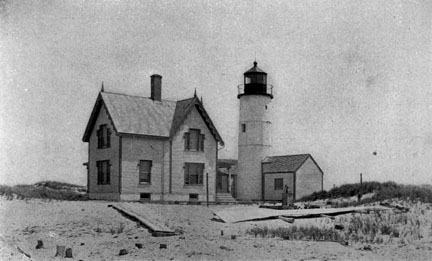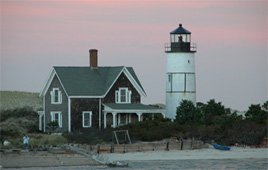|
Sandy Neck Light
The lighthouse was built in 1826 on the site known as Beach Point at the time. The first Sandy Neck lighthouse consisted of a wooden lantern on the roof of a brick keeper's house. The lantern originally held 10 lamps and reflectors, emitting a fixed white light, and was visible for nine miles out to sea.
The lighthouse was deemed necessary largely because it helped mariners avoid the dangerous sand bar that extended from Sandy Neck. The constant Cape Cod weather took a toll on the lighthouse, and as a result, the lighting apparatus had become worn out and dirty so it was later upgraded.
An 1850 inspection report reveals that the lantern had been raised some 8 or 10 feet, and a new system of seven lamps and 14-inch reflectors was in use. The inspection found everything in good order under Keeper Thomas Baxter, and it noted that erosion had washed away a large amount of the shore near the lighthouse. The original Sandy Neck lighthouse was replaced in 1857 by the 48-foot brick tower that still stands today. It is located a little bit north of where the first light stood. The distinctive pair of iron hoops and six staves that surround the central part of the lighthouse, were added in 1887 to help stop the progression of cracks in the tower. Several repairs to the original housing kept it suitable for living, but the 1880 annual report of the Lighthouse Board deemed the house "beyond repair." The following year's report noted that the old house had been replaced by a new, wood-frame structure, with brick inner walls. The six-room Queen Anne Victorian dwelling still stands today. Barnstable Harbor gradually declined in importance, and shifting sands left the lighthouse in a less effective position. In the summer of 1931, when William L. Anderson was keeper, the lighthouse was decommissioned and its lens was moved to a steel skeleton tower 200 feet closer to the tip of Sandy Neck. The new automated light was fueled by acetylene gas and was operated seasonally, from mid April to mid October until it was discontinued in 1952.
The lantern was removed from the lighthouse and in 1933, the property was sold at auction. The Sandy Neck Light was sold two more times and is owned today by the Hinkley family. In 2004, the family began working with the Cape Cod Chapter of the American Lighthouse Foundation to have a replica lantern installed on the tower in time for its 150th birthday in 2007. The installation of a new lantern began in the spring and summer of 2007. The job was completed in the fall, and in October 2007 the lighthouse was relighted as a private aid to navigation, with a modern LED optic.
The lighthouse can be viewed from a distance across Barnstable harbor at Millway Beach. To get to the beach: Take exit 6 off Route 6 north to Barnstable. Turn right (east) on 6A, and turn left (north) on Mill Way. The beach is at the end of the road. Return to Cape Cod Lighthouses from Sandy Neck Light
|


